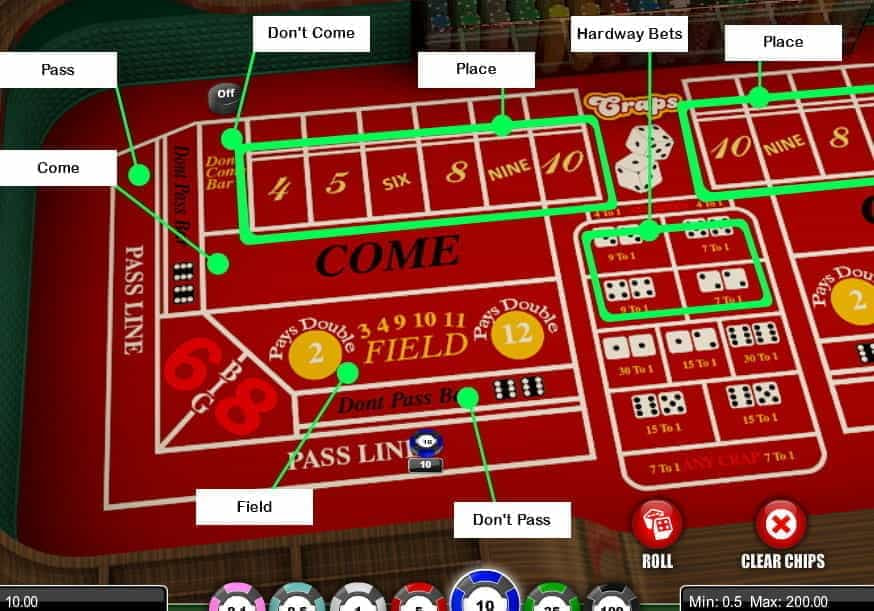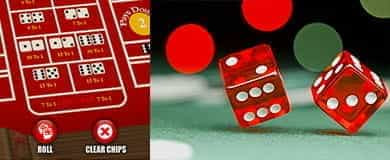Craps Triple Lux
3200 Las Vegas Blvd. South Suite 2000 (789.31 mi) Las Vegas, NV, NV 89109.
What About Crapless Craps? Is It Playable?
It seems to be a law of the gambling universe. If a casino promotes a game as better than the standard game, it is always worse – for the player, not the casino.
- Learn how to play and deal Casino Table Games. Learn Craps, Blackjack, Roulette, Baccarat and Poker. Located on the Las Vegas strip inside Fashion Show Mall. Online Casino Classes, Casino Discussion Forums, Live Streams and Game play Channels.
- I tried Triple Lux at Casino de Montreal back on Tuesday and I hit one of my place numbers three times, power pressed twice and took the payout the third time, but then sevened out soon after. Sounds like a decent strategy but I need to have a nice long roll. A couple other rounds of triple lux were short and anything but sweet.
In craps a few casinos are offering 'Crapless Craps' or 'Never Ever Craps.' The casinos proclaim, 'Never lose your pass line bet due to a craps number being thrown.' I don’t know about you, but I just hate it when my pass line bet is scooped up because a 2, 3, or 12 shows on a come-out roll. So this is a good thing, right?
The answer, as expected, is no. Instead of losing your pass line bet when a craps number is thrown, it becomes a point number. However the 11 – normally a pass line win on come-out – also becomes a point in crapless craps. The probability of making a point of 2 or 12 is 1 in 7. The probability of making a 3 or 11 is 1 in 4. Because you still only get even money for your pass line bet, the house edge for a pass line bet in crapless craps is 5.38 percent. The house edge for a pass line bet in the standard game is 1.41 percent. Now you know why casinos push crapless craps.
Golden Touch™ teaches that you should only play the games where you have an advantage. Whether or not you have an advantage in craps is determined by your skill in controlling the dice. The amount you can expect to earn because of your advantage not only depends on your skill, but also the bets you make at the craps table. For example, if you have diligently practiced over several months and your documentation shows you have avoided enough 7’s to garner a 5 percent edge, you will have nearly a 3.6 percent edge on a pass line bet in a standard craps game (5% minus 1.4%). In crapless craps, however, the house still has an edge of 0.38% (5% minus 5.38%).
Compared to the difference in pass line bets, the additional place bets on a crapless craps layout are even more heavily tilted to the house. Placing the 3 or 11 carries a house edge between 6.25 percent and 10 percent depending on the casino. The 2 or 12 place bets make between 7.14 percent and a whopping 14.29 percent for the house.
Based on this information, common sense dictates you should play the standard game. But what if the regular tables are full or your spots are taken? What if crapless craps is the only game open?
The GTC preferred betting method for random rollers is a pass line and one or two come bets with odds after the 5-count. If you are a controlled shooter you want to minimize what you bet on random shooters and bet considerably more on your own rolls. With this in mind, a pass or come bet with double odds in standard craps has a 0.61 percent house edge. The same bet with double odds in crapless craps has a 2.02 percent edge making in a much less desirable bet. It makes placing the 6 and/or 8 a less costly option as that bet carries a house edge of only 1.52 percent, and has a hit frequency second only to the 7.
Okay, for random rollers in a crapless craps game it is better to place a 6 and/or 8 instead of making pass line and come bets. What about betting on your own rolls?
If you are a controlled thrower (and you are throwing well), the GTC preferred method is to make place bets. The 6 and 8 are preferred for their low house edge (1.52%). Since you are betting more on your own throws, buying the 4 and/or 10 (with the vig paid only on a win) is also a reasonable bet at about a 1.67% house edge. This edge can be lowered if you can 'push' the vig from $1 on a $20 bet (1.67%) to $1 on a $25 bet (1.33%) to $1 on a $30 bet (1.11%) possible even to $1 on a $35 bet (0.95%).
But what about those extra place bets available in a crapless craps game? What about betting on the 2/12 or the 3/11?
As you might expect, the house edge on a place bet for these numbers is abysmal. The true odds against making a 3 or 11 are 3-to1. For making a 2 or 12 they are 6-to-1. The games I looked at in Las Vegas and Tunica paid 13-to-5 on the 3/11. This translates to a hefty 10.00% house edge. In Las Vegas placing the 2/12 pays 5-to-1 amounting to a 14.29% windfall for the casino. In Tunica it was a little better, paying 27-to-5 amounting to 'only' an 8.57% casino advantage. By contrast, placing the 4/10 – with true odds of 2-to-1 – gets paid at 9-to-5 for a house edge of 6.67%.

The message is clear and simple; avoid place bets on the outside numbers, especially the very outside numbers. However, buying these numbers can minimize the tax on your wins by the casino.

Tunica allows buying the 3/11 for $10 with a $1 vig. This amounts to a 2.5% house edge. However if you buy the 3/11 for $25 as is allowed in Las Vegas as well as Tunica, the house edge plummets to 1.00%. If this isn’t enough to get excited about, consider buying the 2/12. In Tunica buying the 2/12 for $10 with a $1 commission puts the house edge at a decent 1.43% - just about the same as a pass line bet. But, if you buy it for $25, you still only pay a $1 vig on a win and the house edge is now a mere 0.57% - almost the same as a blackjack game that has decent rules.
Craps Triple Lux Vs
Now that is something to get excited about. A controlled thrower does not need very much control to overcome about a half percent house edge. On top of that, hitting the 2 or 12 with a $25 buy bet pays $149. Heck, that is almost as much fun as hitting a Hardway bet. It makes it very tempting to change your set to make hitting these far outside numbers a bit more likely.
So, the next time the only open table is a crapless game, you don’t need to walk past it, you just need to be selective with the numbers you bet on and the type of bets you make. As an added bonus, hitting the extreme outside numbers can quickly increase your bankroll with very little taken by the house as a vig.
And remember, He who dies with the most toys … is nonetheless dead.
Happy (crapless) rolling,
Stickman
Yes, I've seen that bet in Tunica. I address it in my blackjack appendix 8. I agree that side bet would seem very countable.
This is a sucker bet. The most likely time the dealer will bust is with a 6 up. However even then the dealer will only bust 42% of the time, give or take depending on the exact rules, for a house edge of 16%.
The probability of three seven of diamonds is combin(6,3)/combin(312,3) = 0.00000398937. The probability of three unsuited sevens is (combin(24,3)-combin(6,3))/combin(312,3) = 0.000399735. According to my blackjack calculator the house edge is 0.6233%. The expected loss on a $5 bet would be 3.12 cents. Just the value of the $50 for three unsuited sevens is $50*0.000399735=2.00 cents. To make up the other 1.12 cents the meter would need to reach $2802.
The wheel in Wheel of Madness is weighted. In other words it is designed to stop on the lower prizes more often. Without knowing the exact weights I can’t analyze it. I have tried to get the weights from casinos and the manufacturer but alas have had no luck.
Spirit Mountain Casino in Grand Ronde Oregon added a side bet in the last 24 hours called 'Field Gold 21.' It resolves before the rest of the hand begins and concerns the first two cards dealt to a player. The side bet can be between 1 and 25 dollars. The pay table follows.- Ace, Jack Suited = 25 - 1
- 2 Aces = 10 - 1
- 3 or 4 Total = 3 - 1
- 9 or 10 Total = 2 - 1
- 11 or 12 Total = 1 - 1
- Any Blackjack = 3 - 2

Aces always count as 1 and 10’s and faces count as 10. What is the house advantage? If I keep an Aces and Fives count is there a positive count where the possible remaining aces make the bet a positive proposition? Would counting remaining aces divided by remaining decks be better?
You didn’t tell me the number of decks, but assuming six the house edge is 5.66%. Here is the return table.
Field of Gold — Six Decks
| Event | Pays | Permutations | Probability | Return |
| Ace/jack suited | 25 | 144 | 0.002968 | 0.074202 |
| Two aces | 10 | 276 | 0.005689 | 0.056888 |
| 3 or 4 total | 3 | 1428 | 0.029434 | 0.088301 |
| 9 or 10 total | 2 | 4884 | 0.100668 | 0.201336 |
| Any other blackjack | 1.5 | 2160 | 0.044521 | 0.066782 |
| 11 to 12 total | 1 | 6612 | 0.136285 | 0.136285 |
| All other | -1 | 33012 | 0.680435 | -0.680435 |
| Total | 48516 | 1 | -0.056641 |
Triple Lutz
Just eyeballing it, I would say aces would be the best card to track, betting into an ace-rich deck. My advice would be to count aces as −12 and all other cards as +1.
There is one way to get the ace and four ways to get the 10-point card, for a total of 1*4=4 winning combinations. There are combin(52,2)=1,326 ways to choose 2 cards out of 52. So the probability of winning is 4/1326 = 0.30%. Fair odds would be 330.5 to one. The expected return is 0.0030*300 + 0.9970*-1 = -0.0920. So the house edge is 9.2%.
The reason they limit this bet to the first hand after the shuffle is a card counter could take advantage it otherwise. Without tracking the cards, you can assume the house edge is 9.2% all the time.
For the benefit of other readers, the Match the Dealer side bet pays when either of the player’s first two cards match the dealer’s up card. A traditional count is not going to be useful against this side bet. Rather, the odds would swing to the player’s advantage if the distribution of cards by rank were unusually unbalanced. It isn’t going to be practical to keep track of 13 different suits. The Big Book of Blackjack by Arnold Snyder, which I highly recommend, has a short chapter on how to beat a similar bet, the ’Royal Match.’ With only four suits to worry about, this side bet is vulnerable to the method described in that book in a single-deck game.

Yes! That side bet is extremely vulnerable to card counters. As long as the minimum is not too low, you should be using another strategy to exploit it, one that treats aces as a low card. Arnold Synder presents such a strategy in The Big Book of Blackjack. Otherwise, if you are using a standard hi-lo count, Synder says to only make the Over bet in very high counts.
It sounds like you are talking about Lucky Pairs, a side bet that wins if the player’s first two cards are a pair. Many baccarat tables also offer this bet. As I show in my baccarat page, the house edge is 10.36%, assuming eight decks. In either game, you would pretty much need to eliminate all cards of at least one rank to have an advantage. To know that, you would need to keep 13 different counts. In baccarat, this could be done, since you are allowed to take notes while you play. However, based on some very extensive analysis, profitable opportunities don’t happen often enough for this to be a practical use of time.
I have not studied the effect of card counting of that bet for myself. However, Arnold Snyder has, and his results can be found in his Big Book of Blackjack. There he says you should make the bet in a six-deck game if it is the last two decks, and the count is +10 or greater, using the Red Sevens count. In a double-deck game he says to bet in the last deck, and a count of +6 or greater.
Based on six decks, I get a house edge of 3.40%. I show all my math in my blackjack appendix 8. An extremely high or low count would indicate the ranks in the remaining cards are clumped together, which would lower the house edge, but I don’t think it would be enough to warrant bothering with.
This question was raised and discussed in the forum of my companion site Wizard of Vegas.
My blackjack appendix 2B was created for questions like this. It shows the probability the dealer will bust is 28.19% under those rules. That would make the house edge 1.33%.
This question was raised and discussed in the forum of my companion site Wizard of Vegas.
At the Lake Elsinore Hotel and Casino in California there is a blackjack side bet called the Red Flex. It pays according to the number of consecutive red cards in the dealer's hand, starting with the first card. The pay table is as follows:- Seven or more reds pays 200 to 1
- Six reds pays 100 to 1
- Five reds pays 50 to 1
- Four reds pays 10 to 1
- Three reds pays 5 to 1
- Two reds pays 1 to 1
If the dealer busts, or isn't required to draw cards because all the players busted, the dealer will still draw cards as necessary to adjudicate the side bet.
Triple Lux Craps System
What are the odds?Craps Triple Lux Car Wash
I show my analysis of the Red Flex in my blackjack appendix 8.
This question is discussed in my forum at Wizard of Vegas.
Craps Triple Lux Lounge
I found a blackjack dealer who exposes his hole card when peeking for blackjack. He offers insurance after peeking. So, when the dealer has an ace up and I can see a 10, I take insurance. How much does this reduce the house edge of the overall game?
Ice Skating Triple Lux
Let's assume six decks. The probability of the up card being an ace is 1/13. Next, the probability the hole card is a 10-point card is 96/311. So, this opportunity will occur 2.37% of hands.

The insurance bet I assume will be half a unit and insurance pays 2 to 1. So, every time this happens, you can expect to gain a unit. Since it happens with probability 2.37% of the time, that is what it is worth to you. Subtract the house edge under whatever the blackjack rules are to get the overall player advantage of the game.